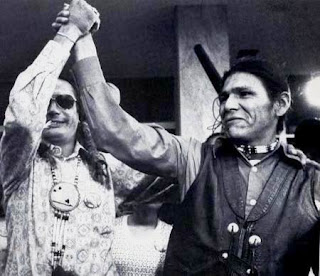
This is...............someone.
I really have no idea who these people are - the 3.5" x 3.5" black and white photo fell out of
Air Conditioning Metal Layout (1952 edition).
What brought a smile to my face is that these folks could
easily be my mother's family. In fact, my grandmother had this same chair in her livingroom for years, alongside it's matching couch.
Judging from the fashions, the furniture, and the eyeglass frames, I'm thinking this was a 1940's Christmas (see the tree in the back corner?), and that little girl should now be roughly anywhere from 65 to 71 years old.
They are probably a farming family (going by the overalls - my grandpa wore them everyday, changing only if there was a funeral to attend), and this may be mom and dad, with the son and daughter, and the only grandchild to date. Or possibly dad and mom, with the daughter and her husband and child. Or dad with the three kids, and one grandchild.
Or even dad, and the unmarried sister that stayed at home is on the left, while the married sister is behind dad (looking prettier), while her husband holds the grandchild.
No one is wearing any jewelry at all, not even wedding rings. The man on the right definitely has a more white collar job. Looks like a silk tie he's tucked in to keep clean. Yep, while he has a friendly face, he definitely looks like a city-slicker come to visit on the holiday.
The man in the overalls probably isn't a tobacco chewer, since there's no snuff can or pouch in his overalls, but more importantly, his face is relatively unlined, and doesn't have the heavily aged look of a chewer or smoker .
The door behind them has a large glass panel, so it might be an entry door, but the glass has been covered and "decorated" with fake snow glaze. With the chair sitting so close to it, looks like they don't use this door much.
You probably can't see it in the picture, but the floor has a pretty floral carpet on it, and the light switchplate is brass (common in the 1940s), and the "switch" is actually the old-fashioned buttons. The Christmas tree has garlands on it, but they are commercial, not homemade.
I hate the idea of orphan pictures. Somewhere, some family historian is wondering where the pictures went from the farm. Or that little girl has grown up, and is wishing she had a picture of her with her dad and grandpa.
I have lots of these orphaned photos. I have been known to buy them by the box at yard sales when someone has had the shortsightedness to throw them away. Or at estate sales when no one is left who values them, and there they sit for $5.00 in a box lot.
 This is my favorite orphan photo- I have it up on my bulletin board by my desk.
This is my favorite orphan photo- I have it up on my bulletin board by my desk.
Maybe this smartly dressed young mom took it to send to her husband overseas so he could see the baby. The clothes and hair dates it to the 1940s, and she has a flower in her buttonhole, complete with pumps with little bows. The baby is dressed in the best - crisp little dress, and a crocheted jacket (with duckie). Last but not least, there's a patient Boston Terrier sitting at their feet, guarding the family till Dad gets home. He looks very Winston Churchillish.
Every picture tells a story. Especially the orphans.
Addendum: Thinking about it overnight, it occurs to me that the last photo may be someone in Europe - maybe sent to reassure relatives that she was okay, that she still had plenty of time to leave. Or maybe just after the war, and she's a war bride, waiting for papers so she can come over to the U.S. and join her G.I. husband. Looks as if she's sitting on a sortof canal, and there's are lots of those in The Netherlands, as well as Florida. Trendy 40's hats, duckie's on baby clothes, and even Boston Terriers were all fairly common, so, still an orphan photo.
Let this be the push you need to go and LABEL your photos. Even if you remember who those people are, 50 years from now, chances are no one else will.
 Hmm.
Hmm.
 This morning, safe in her bed, in her nursing home room in England, Melvina died peacefully in her sleep.
This morning, safe in her bed, in her nursing home room in England, Melvina died peacefully in her sleep. 


























































